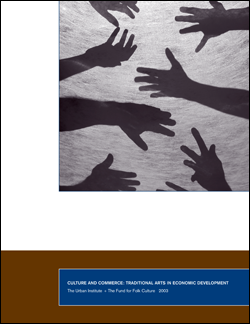501(c)(3) non profit grantmaker
501(c)(3) non profit grantmaker
2002, 71 pages. RMC Research Corporation in partnership with the Pew Charitable Trusts. Available through the Center for Arts and Culture, Suite 500, 819 Seventy St., N.W., Washington, DC 20001, 202-783-4498.
Read More...Each of the following Web sites is located somewhere on a continuum between the state of the union and the state of the arts.
The Web is a particularly effective medium for creating visual diagrams of events and practices from daily life. According to Paul Miller, one site's creator, we live in a "world of uncertainty." Each of the following sites, in its own way, diagrams an aspect of our uncertain world.
The first site delineates the historical context for current Web projects.
Read More...2003, 13 pages. Saint Paul Foundation, 651-224-5463, www.saintpaulfoundation.org
Arts LAB reports on a three-year pilot program developed by a collaborative of six Twin Cities foundations, convened by the Saint Paul Foundation, to strengthen small and mid-sized arts organizations in Minneapolis and St. Paul.
Read More...2003, 52 pages. Fund for Folk Culture, P.O. Box 1566, Santa Fe, NM 87504-1566, 505-984-2534, www.folkculture.org; Urban Institute, 2100 M Street, N.W., Washington DC 20037, 202-833-7200, www.urban.org.
Download:
Read More...Editors of the Reader invited GIA's research advisors to reflect on challenges facing arts grantmakers in light of current research findings on arts funding trends.
What do recent research findings suggest about the prospect for the support of arts and culture in the years ahead?
Ed Pauly: After a decade of dramatic growth in foundations' support for the arts, the funding news is now somber. Yet the meaning we make from the most recent study of foundation funding for the arts depends, as always, on the perspective we choose.
Read More...Recently, several studies of arts funding have been conducted in specific cities and regions. We report on a few of these here. In the winter 2002 issue of the GIA Reader Vol. 13, No. 1, Lisa Cremin and Kathie de Nobriga reported on a comparative study of arts funding in Atlanta and nineteen other cities. The report was both an inspiring and a cautionary tale for Ann McQueen and others in Boston as they planned the study that Cindy Gehrig reviews below.
Read More...Booms and Busts
From the depths of our economic trough it is hard to look ahead, clear-eyed, and to see where U.S. foundations are headed. But consider, for a moment, where we have been. We have experienced an era in which: :
• New scientific and technological advances captured the popular imagination.
• These innovations promised a huge jump in economic productivity.
• There was talk about a new economy replacing an old economy.
• Many business corporations were consolidated and reorganized.
Arts Funding IV examines recent changes in arts grantmaking by one segment of private institutional donors — private and community foundations. While the larger, more fragmented arena of government and private support lies outside this investigation, it is nonetheless useful to place foundation support within this larger context. The following overview outlines the basic framework of private and public arts funding in the U.S. and discusses funding in relation to the overall financing of nonprofit arts groups.
Read More...Economic language and ideas have increasingly found their way into discussions of artistic value and cultural benefit. For better or for worse, the discipline of economics has been the lingua franca of public policy discourse for at least the past fifty years. Sometimes the terms resonate harshly on our ears. How do people in the world of arts and culture answer those who speak this language, who try to value cultural activity in terms of economic multipliers, cost-benefit analysis, quantitative outcome measures and, a current favorite, contingent valuation methodology?
Read More...In a crowded auditorium at Yerba Buena Center for the Arts, funders, community activists, and artists gathered in March to listen to a panel discussion on hip-hop activism in the Bay Area. The goal of Constant Elevation: The Rise of Bay Area Hip-Hop Activism was twofold: to inform and educate funders about hip-hop activism and how it fits into foundation support, and to highlight local best practices that use Hip Hop as a framework.
Read More...
